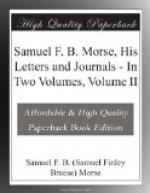As soon as it was proved that it would be simpler to use the letters of the alphabet in sending intelligence, the first form of the alphabet was changed in the manner shown in the preceding figure. Exactly when this was done has not been recorded, but it was after Vail’s association with Morse, and it is quite possible that they worked over the problem together, but there is no written proof of this, whereas the accompanying reproduction of calculations in Morse’s handwriting will prove that he gave himself seriously to its consideration.
The large numbers represent the quantities of type found in the type-cases of a printing-office; for, after puzzling over the question of the relative frequency of the occurrence of the different letters in the written language, a visit to the printing-office easily settled the matter.
This dispute, concerning the paternity of the alphabet, lasting for many years after the death of both principals, and regrettably creating much bad feeling, is typical of many which arose in the case of the telegraph, as well as in that of every other great invention, and it may not be amiss at this point to introduce the following fugitive note of Morse’s, which, though evidently written many years later, is applicable to this as well as to other cases:—
“It is quite common to misapprehend the nature and extent of an improvement without a thorough knowledge of an original invention. A casual observer is apt to confound the new and the old, and, in noting a new arrangement, is often led to consider the whole as new. It is, therefore, necessary to exercise a proper discrimination lest injustice be done to the various laborers in the same field of invention. I trust it will not be deemed egotistical on my part if, while conscious of the unfeigned desire to concede to all who are attempting improvements in the art of telegraphy that which belongs to them, I should now and then recognize the familiar features of my own offspring and claim their paternity.”
[Illustration: QUANTITIES OF THE TYPE FOUND IN A PRINTING-OFFICE Calculation made by Morse to aid him in simplifying alphabet]
CHAPTER XXIV
OCTOBER 3, 1837—MAY 16, 1838
The Caveat.—Work at Morristown.—Judge Vail.—First success.—Resolution in Congress regarding telegraphs.—Morse’s reply.—Illness.—Heaviness of first instruments.—Successful exhibition in Morristown.—Exhibition in New York University.—First use of Morse alphabet.—Change from first form of alphabet to present form.—Trials of an inventor.—Dr. Jackson.— Slight friction between Morse and Vail.—Exhibition at Franklin Institute, Philadelphia.—Exhibitions in Washington.—Skepticism of public.—F.O.J. Smith,—F.L. Pope’s estimate of Smith.—Proposal for government telegraph.—Smith’s report.—Departure for Europe.




